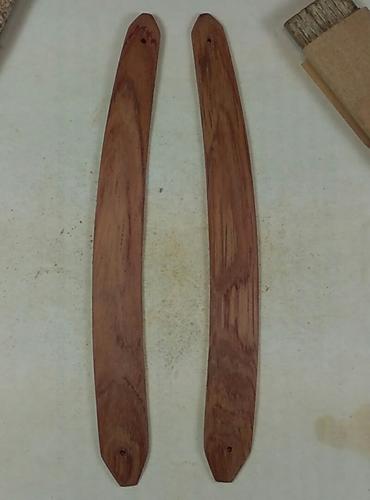Results 1 to 10 of 12
Thread: Varnish for wooden scales?
Hybrid View
-
01-11-2024, 11:52 PM #1

Tru-oil Gun Stock finisher works nice too. But its a lot of work.
It's just Sharpening, right?
Jerry...
-
01-12-2024, 02:59 AM #2

I use a brush on poly. It leaves a really nice finish but it takes some practice to get it right. I usually put a coat and sand to opaque a couple of times then put a very thin coat of some thinned about a quarter to finish. Hard to get it thinned properly without getting bubbles but if your patient stirring it works well.
Iron by iron is sharpened, And a man sharpens the face of his friend. PR 27:17
-
01-12-2024, 02:59 AM #3

My preference is "True-Oil"
It really makes the wood come to life, compared to others. It is time consuming building the layers, once the grain is filled.
But the results are worth it.


Being a gun stock finish, it'll handle anything you can throw at it.
Super glue tends to crack from the scales flexing, from what I've seen from those I've done.Last edited by outback; 01-12-2024 at 03:04 AM.
Mike
-
01-12-2024, 03:02 AM #4

Tru oil does leave a nice finish but if the wood is very dense and hard it won't penetrate, at least on that southern live oak heart wood. That stuff is the hardest, densest wood I've ever worked with. For that I use gun stock wax and leave it in the sun for about 10-12 coats
Last edited by PaulFLUS; 01-12-2024 at 03:05 AM.
Iron by iron is sharpened, And a man sharpens the face of his friend. PR 27:17
-
01-12-2024, 03:24 AM #5Senior Member

- Join Date
- Jan 2022
- Location
- canada
- Posts
- 468
Thanked: 58
Minwax wipe on Poly is foolproof and pretty durable.
Lacquer in a spray can works well too and each coat of lacquer melts into the last creating one thick coat essentially.
Shellac does the same thing melting into previous coats. (not durable though)
Urethane/varnish and polyurethanes adhere between coats but do not melt into the previous layer to become one.
Polyurethanes being the most durable of this group.
-
01-12-2024, 05:50 AM #6

I like superglue. First coat thin, don't sand. Second coat thick, sand lightly with 1k, then buff with basically any fine buffing compound and a scrap of old tshirt. Start doing thin coats, buffing only, until you get the depth effect you want. Two part epoxy or polyester casting resin can be absolutely stunning when you really nail it. You need some sort of motorized apparatus for turning it, though, so you don't get runs. I have used double boiled linseed oil, too, but it takes weeks to apply and age the two or three coats you want. Tung oil is good on some woods, like ebony or walnut. These oils oxidize and for best effect they need to age a bit before buffing and handling. A simple polyurethane varnish is the painless way, or some good shellac or clear lacquer. Krylon clear actually works surprisingly good. Spray it on LIGHTLY, then a couple more light coats a day apart in a completely dust free environment, Buff with clean cotton tshirt between coats and lightly with a clean cotton wheel at low speed, at the end, after curing for 3 or 4 days. More than one way to gitter done. When you make wood scales, don't make one pair. Make three. Try stuff. Toss them when you screw up and don't let it mess up your digestion. A common mistake is overbuffing the finish on a wheel. You WILL do that at least once. It is a given. Another is not knocking down the lint and bubbles in a coat before applying the next. Another is letting drips and runs solidify, which are surprisingly difficult to sand smooth without trashing the whole thing and having to start all over. That is one advantage of wax type finishes, is that they don't completely solidify and simple rubbing brings the luster back, and you can reapply any time you think you would like to.
-
01-12-2024, 06:30 PM #7Senior Member

- Join Date
- Jan 2007
- Posts
- 373
Thanked: 31
Lots of interesting suggestions here!
I looked up the ingredients of some of the more natural materials (such as Tru-oil) and found linseed oil plus natural resins. Turns out I have some similar stuff, since I have lots of artist's materials. I have linseed oil (and boiled linseed oil), dammar varnish, and turpentine. Looking around some more I saw one suggestion of a 1:1:1 mix of these. I'm testing on an old wooden broom handle first
-
01-12-2024, 08:45 PM #8

Yes. Tru oil is a mixture of oils. But ratio..
 All I can say is, I've used it for a few gun stocks I've refinished, and hunted with for years. ( Lots of brush, and briars, snow, rain, ice.) still looks new.
Mike
All I can say is, I've used it for a few gun stocks I've refinished, and hunted with for years. ( Lots of brush, and briars, snow, rain, ice.) still looks new.
Mike


 19Likes
19Likes LinkBack URL
LinkBack URL About LinkBacks
About LinkBacks








 Reply With Quote
Reply With Quote

